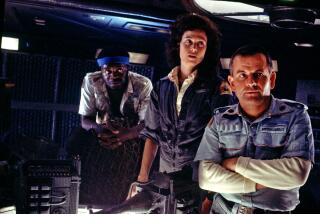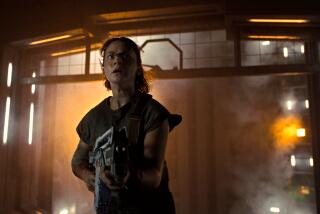‘Wall-E’s’ world may not be so far away after all
The mobile trash compactor is a symphony of squeaks, thunks and rattles, rolling forward on treads to bring its pivoting eyes to bear on us. Within moments we identify completely, launching “Wall-E,” one of the rare films to feature robots as the lead characters.
Pixar knows how to create identity in a few signals. Research on “facebots” at MIT shows that the mere impression of a face’s essentials -- sympathetic eyes and a mouth -- can evoke emotion from us. We read facial features in machines and take them as social signatures.
The character of Wall-E follows in the treads of R2D2 of “Star Wars” fame. Body language, vocalizations and expressive eyes hook us into Wall-E’s plucky story.
The genteel bachelor world of this last garbage robot on Earth is disturbed by the terrifying EVA, a sleek, powerful, feminine robot.
As in “2001: A Space Odyssey” (1968) and “I, Robot” (2004), robots also rule on Axiom, the giant spaceship that is humanity’s home in exile. The obese humans are contented and helpless, like the inhabitants of the domed city in “Logan’s Run” and the captive Eloi in “The Time Machine.”
Here in the real world of 2008, robots are the coming wave, and the West has to decide how to deal with them. Will they be the powerful and malevolent robots of traditional science fiction, such as Gort (“The Day the Earth Stood Still”), Cylons (“Battlestar Galactica”), Borg (“Star Trek”), Daleks (“Doctor Who”), the Terminator and RoboCop? Or the helpful and friendly Robby from “Forbidden Planet” and R2D2?
Fiction and film have meditated upon the social issues posed by robots and cyborgs for centuries. In the Jewish folk tale of the golem, in Thomas Edison’s attempts to build an artificial woman, in myriad science fictions, our culture has struggled with these ideas.
American science fiction is uneasy about robotics. Our image of advanced, thinking robots inevitably leads to creations like RoboCop and the Terminator, or the murderous cowboy robot in “Westworld.”
Technology often follows cultural anticipation. Our most advanced robots to date are military ‘bots serving in Iraq, such as the flying Predator craft armed with missiles and the Wall-E-like tracked machine gunners on the ground. The “special weapons observation remote reconnaissance direct action system,” shortened to SWORDS, is a bomb-disposal robot armed with M249 machine guns. It could be Wall-E’s evil twin. If we hadn’t dreamed them in science fiction, would we have these killer robots today?
Importing such technology into domestic life is just around the corner. Security firms will want ‘bots that patrol in the dark, using infrared vision. Wirelessly controlled by humans (or not), they could save money and terrify intruders. Other robots on treads can already enter dangerous situations, like smoke-filled buildings. But will they also be friendly?
Within a decade, autonomous ‘bots will appear in our lives as gofers, guards, factory workers and hospital aides. Already, iRobot’s Roomba vacuums our homes, cleans rain gutters, washes floors. The iRobot nonthreatening home security robot is no bigger than a medium-sized dog. Robot vacuum cleaners, pool cleaners and lawn mowers are like large pond turtles. The Intelecady carries your golf clubs but so far doesn’t offer advice.
How will golfers like a smart-alecky robot telling them what club to play next? Drivers certainly balked at a voice in the car telling them to buckle their seat belt, and that feature disappeared. Talking machines are a social boundary to Americans, whose nervous relationship with increasingly sophisticated ‘bots in their lives will play out in anxieties and edgy humor.
The Japanese Shinto culture is far ahead of us. They see robots much like pets -- nonthreatening, useful, emotional partners. Robotics development in Japan has confirmed this image. Their most popular robots are the friendly robodogs.
But Honda and Mitsubishi have spent large sums to develop ASIMO and Wakamaru, respectively: These are friendly, child-sized, humanoid robots that are ultimately intended as companions for the elderly and disabled but that, at this point, are primarily walking and talking ads for the technology of their creators.
Two months ago, an ASIMO conducted the Detroit Symphony in a performance of “The Impossible Dream” from “Man of La Mancha.” Wakamaru can identify up to 10 people by their faces, including two it considers “owners.”
Using speech-recognition technology to identify 10,000 Japanese words, Wakamaru’s speech synthesis capabilities include voice modulation and using gestures when speaking. It even recognizes nicknames given it by users, Mitsubishi says.
The late science-fiction author Jack Williamson showed us how even such benign robots can become our masters in the “Humanoid” series. Their motto, “To serve and obey, and guard men from harm,” impels the robots to suffocate humankind with kindness, blocking any “dangerous” activity to the point of removing doorknobs. The robots take complete control, reducing the few aware people to frustrated helplessness. This vision reappears in Isaac Asimov’s “I, Robot” when the new robots attempt to take control of human society.
In “Wall-E,” whether robots help or hinder depends on the attitude of the humans. After 700 years of having robot servants cater to their every whim, the humans are sluggish and docile.
The technology is not evil; it’s what the humans have done with it. They are blinded by their viewing screens to the possibilities afforded by swimming pools and jogging tracks.
“Wall-E” presents robots as both servants and masters. AUTO the autopilot looks a lot like HAL from “2001” and is determined to keep control of the ship. Eventually, of course, the humans retake control of Axiom, their lives and their planet.
This story line is cogent in an era when NASA has fielded several Mars rovers in the last decade with plucky names: Pathfinder, Spirit and Opportunity.
More are coming. But who will rule out there? Is NASA making Mars safe for us by pre-positioning useful robots? Or will we see the planet as always too dangerous for human missions?
Axiom apparently has not bothered to explore the solar system -- Buy N Large’s chief executive sells it as a “fun-teer,” not a frontier. Distraction is everything. The real goal is returning to Earth, and in simplified diagrams as the credits roll, robots work with people to recover their world. But the last image is Buy N Large’s logo, with theme song. Who will win, in the end?
--
Gregory Benford is a professor of physics at UC Irvine and a novelist. Elisabeth Malartre is a biologist. They collaborated on “Beyond Human: Living With Robots and Cyborgs” and the novel “The Martian Race.”
More to Read
Only good movies
Get the Indie Focus newsletter, Mark Olsen's weekly guide to the world of cinema.
You may occasionally receive promotional content from the Los Angeles Times.










